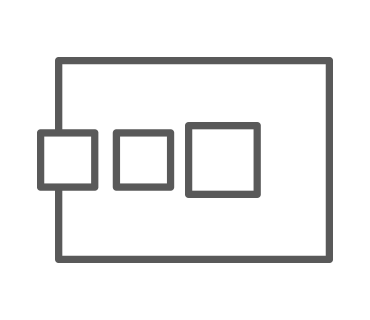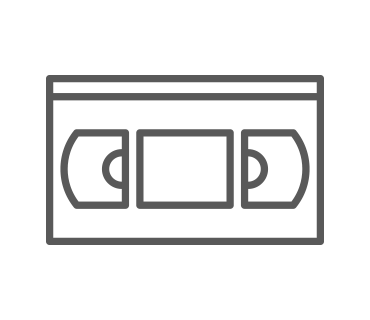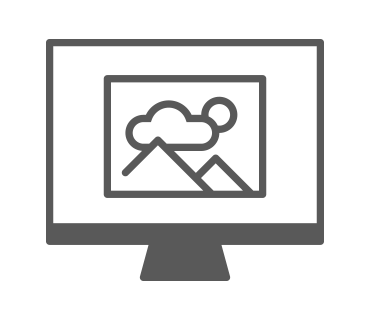Motion Tracking
– here's how it's done.
To move a graphic or photo, title or effect together with a moving subject through the video frame, proceed as follows:
- Open Movie Studio and import your video into track 1. Navigate to the folder containing your video file in the Media Pool, then simply drag & drop the video into the top track.
- Import the overlay object, for example a graphic or photo, to track 2. To move a title using Motion tracking, use a title template from the Media Pool. To use an effects mask, for example, to pixelate a part of the image, apply the effect to the entire image. You can find pixelation in the "Distortion" effect by using the slider "Sand". Then, select an effects mask in the effects dialog, open the "Position/Size" effects dialog and move the effects mask to the desired start position in the preview monitor.
- Right click the overlay object (i.e., the graphic, photo, title or effects mask) and select the option "Attach to picture position in the video".
- If you need to correct the result manually, use the "Position/Size" effect. By using keyframe animation at the bottom of the effects dialog, you can achieve any desired movement for the overlay object.
- Go to "File" > "Export movie" and select an export format in the sub-menu (e.g. MP4) to export the video with the moving overlay object as a video file in different formats. Alternatively, use the buttons in the top right to burn your video to disc, upload it to the Internet, or copy to a smartphone.
Motion tracking with Movie Studio, the video editing software for downright amazing movies:
- Import for all conventional formats
- 1-click Motion tracking
- Manual Motion tracking using keyframe animation
- Intuitive templates & helpful program wizards
- Export in all essential formats, including MP4, MPEG2 and AVI
- Burn videos directly to DVD, upload them to the Internet, or copy them to your smartphone
Motion tracking using overlays
Motion tracking entails attaching an Overlay such as an effects mask or a title on a moving subject in your footage. A simple example of this is the distortion of a vehicle number plate driving through the frame. In this case, only a certain area of the image should be pixelated and the rest should remain unchanged. The pixelated image area should move through the image with the car, so that the license plate cannot be seen at any point.
This is done by creating an effects mask that is moved onto the area of the license plate and pixelates it. Then, the effects mask must move as an overlay together with the underlying subject through the video.
Motion Tracking can also be used, for example, to attach a graphic with a reference arrow or a title plate to the moving subject in the video frame.
Motion tracking is especially easy when the software recognizes the subject and automatically tracks the effects mask. To do this, the video editing software must first analyze the images and separate the subject from its background based on contrast.
If the video's image does not have sufficient contrast, the automatic feature will not be able to recognize the subject correctly. In such cases, manual corrections must be made and the overlay object must be placed on the correct position manually.
A good software for motion tracking should therefore offer both options: Automatic motion tracking and the possibility to move overlays freely within the frame.
For instance, video editing software Movie Studio Platinum offers all the tools you need. It offers both: Powerful automatic motion tracking and manual motion tracking for all types of overlays. The process is especially easy and straightforward – even if you're a beginner.
Our step by step guide below shows you how to use Motion tracking in Movie Studio Platinum.
Import video
- Open Movie Studio Platinum and create a new project in the start dialog.
- Drag & drop the video into the top track.
- Place the playback marker at the position in the video where Motion tracking should begin.
Next, create an overlay object that moves through the image together with the image's subject. You can use a title, an image object (photo or graphic) or an effect mask. The process for each are, however, slightly different. For that reason, we'll explain them separately in the following.
Creating titles for Motion tracking
If you want to attach a title to a subject in the image using motion tracking, create the title first. There are several ways to do this:
- By clicking the T-button in the toolbar, you create a normal text display, which you can format as you wish in the "Title editing" dialog . Professionally designed templates for titles and subtitles can be found in the "Templates" directory of the Media Pool in the category "Title templates". Drag this to track 2 and insert your own text. In the "Templates" under "Image Objects" > "Text", you can also find speech bubbles which you can fill with text and attach to a subject in an image using motion tracking.
- Enter your text and change the format settings of the font if necessary.
- Click directly on the title in the preview monitor, adjust it to the desired size and drag it to its start position for the tracked motion.
- If necessary, lengthen the display time of the title by dragging the object in the track using the lower right handle.
Creating image objects with Motion tracking
To add a photo or graphic as an overlay with motion tracking, follow these steps:
- Select the file in the Media Pool and drag it to track 2 under the video. If necessary, lengthen the display time by dragging the object using the lower right handle.
- In the Media Pool under "Templates" > "Image Objects", you will find a variety of graphics that you can use for motion tracking. These included graphics work similar to effects, i.e. you must first select the video object and can then load the image object via drag & drop.
- Select the image object on the track and open the effect "Position & Size".
- Use the handles in the preview monitor to drag the image to the appropriate size. You can also rotate the graphic in the image using the top handle.
- Drag it to its start position in the preview monitor.
Creating effects masks using Motion tracking
You can also attach an effect mask to the subject in the video using motion tracking.
- Click the video in the track to select it.
- Open the effect that you want to use. The sand effect in the "Distortion" effects dialog is ideal for pixelation. First, apply the effect to the entire image.
- Click on the arrow button in the top right corner of the Media Pool and select the option "Load effects mask".
- Select the desired effects mask. The effects mask will appear on track 2 below the video.
- Under "Effects" in the Media Pool, select the effect "Position & Size".
- Use the handles in the preview monitor to drag the effect mask to the appropriate size and position.
Automatic Motion tracking
All further steps are the same for all overlay types (i.e., title, image object or effect mask).
- Right click the overlay object in the track and select the option "Attach to picture position in the video".
- This will open the info dialog about the details of the Motion tracking process. Click "Next".
- Select an image range in the preview monitor, which you would like to use for the movement of the overlay object. This section should have as high a level of contrast as possible. Draw a rectangle with the mouse over this area.
Then, the movement for the motion tracking is calculated. You can view the calculation in the preview monitor directly.
If you are not satisfied with the result, you can also adjust the motion tracking manually or correct parts of the automatic motion tracking manually.
Manual Motion tracking
To animate your object overlay effect manually, use the keyframe animation tool below in the effect dialog "Size/Position". You may have to make this range visible first by dragging down the bottom border of the Media Pool.
Using the keyframe animation, you can create movements for the overlaid object.
- Position the playback marker at the start of the animation and drag the overlay to its starting position on the preview monitor.
- Open the keyframe animation tool and place an initial keyframe.
- Move the playback marker to the right a bit, then move the overlay to the position where you want it to appear at this point in time. It is also possible to change not only the image position but also the size or the rotation, if desired. The program will automatically create the right keyframe as well as the movement of the picture.
If you play the sequence now, you should see the picture move from the first position to the second position.
The closer together you move the two keyframes, the faster the movement. You can adjust the keyframes, as well as the position of the image, at any time in the keyframe animation tool.
Export your Motion tracking videos as files, to a smartphone, burn them to a DVD or upload them to the Internet
- To create a single file which contains all of the footage in the project window, go to "File" > "Export movie". You should now see a list of available video formats. Select the format you want to use (e.g. MP4), give the video file a name and start the export process.
- Alternatively, you can burn your project with Motion tracking to DVD, AVCHD or Blu-ray Disc. Simply click the button in the upper right-hand corner of the program window to open the burn interface.
- You can also upload your project directly to YouTube or Vimeo. Simply click the Finish Movie button in the upper right-hand corner, select Upload to Internet and select "YouTube" as the Community. The project with Motion tracking will be automatically exported in the right format and uploaded directly to your account.



